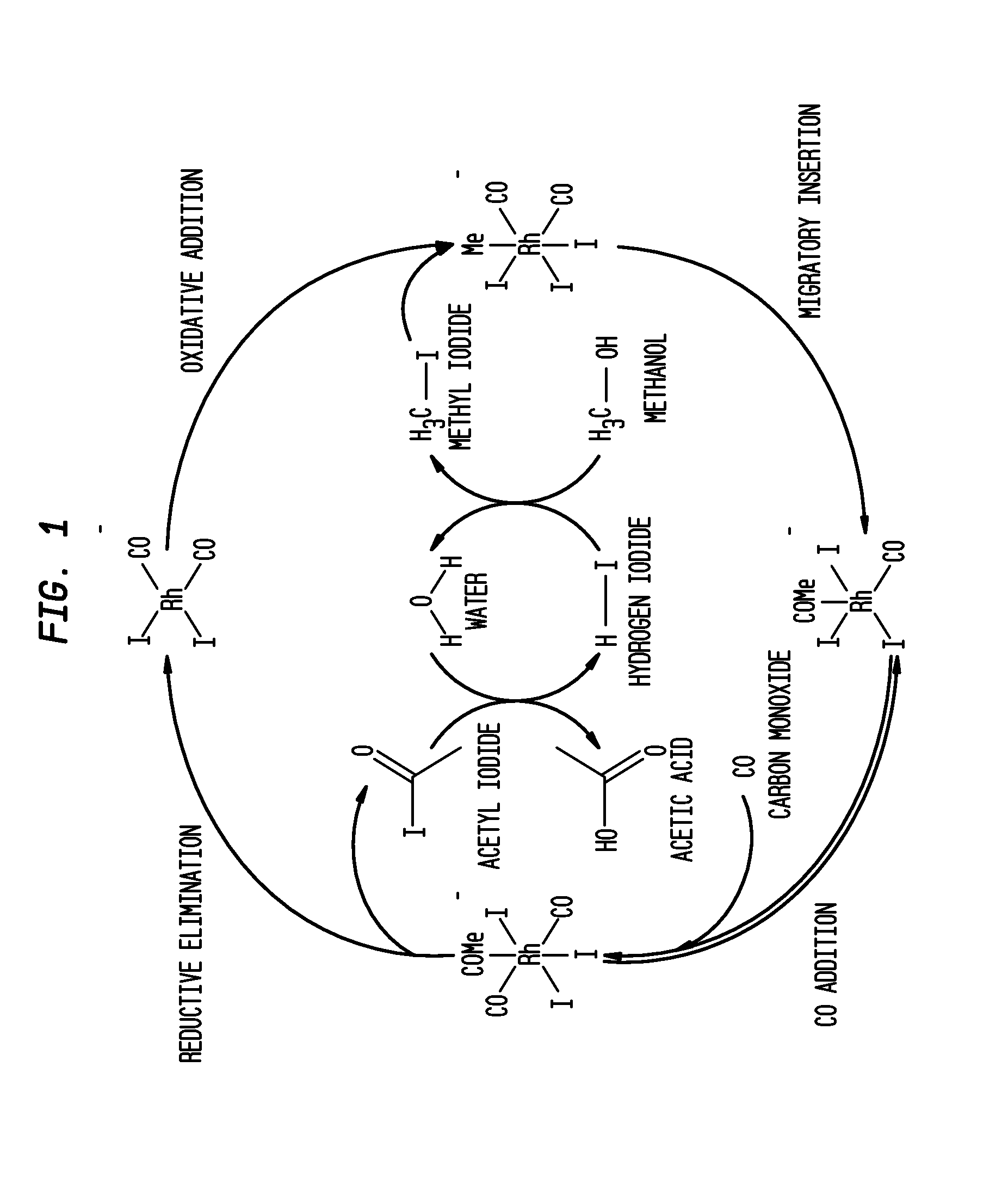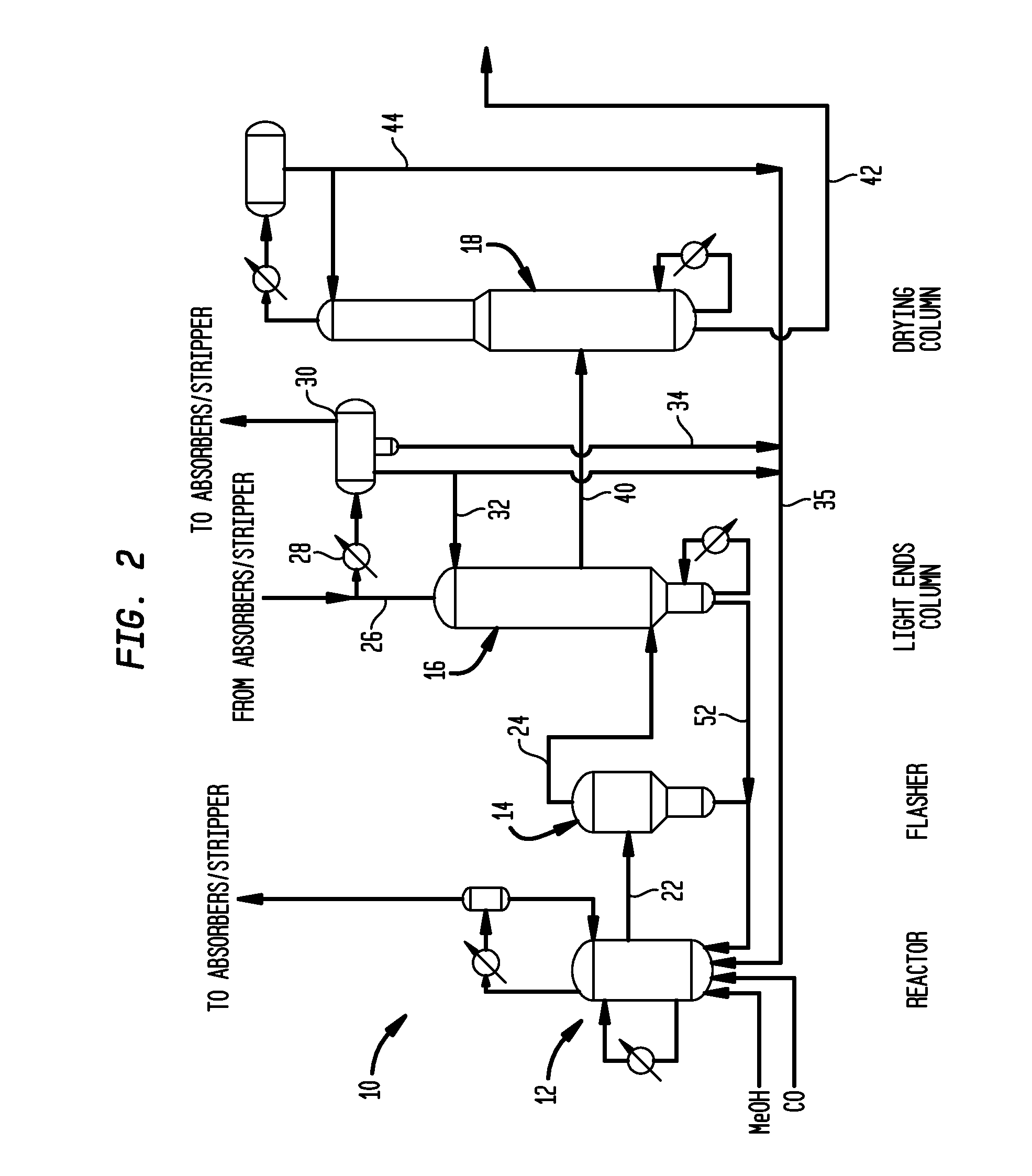Methanol Carbonylation Process with Rhodium Catalyst, an Iodide Salt and a Metallic Co-Catalyst Selected from Transition Metals, Indium, Strontium, Barium, Zinc, Tin and Heteropoly Acids
a carbonylation process and rhodium catalyst technology, applied in the direction of carbon monoxide reaction carboxylic preparation, organic chemistry, organic compound preparation, etc., can solve the problems of increasing the level of propionic acid, particularly difficult to remove alkyl iodides in the system, etc., to preserve catalyst stability and high rate
- Summary
- Abstract
- Description
- Claims
- Application Information
AI Technical Summary
Benefits of technology
Problems solved by technology
Method used
Image
Examples
examples
Comparative Experiments
[0058]Utilizing a pilot scale apparatus simulating the reactor and flasher of the class described above in connection with FIG. 2, a lithium iodide promoted carbonylation system was operated for comparison with a system of the invention. Specifically, Rh(OAc)3 (1000 ppm Rh) was introduced into a reactor such as reactor 12 with AcOH / H2O / HI; the mixture was pressurized under 5 bar of CO at 140° C. during a 1 hour preformation step. The temperature was then increased in the reactor to 190° C. At that time methyl acetate, methyl iodide and the carbonylation catalyst precursor were introduced from a feed tank into the reactor. In a flash vessel such as that shown as flasher 14 of FIG. 2, a mixture of H2O / AcOMe / MeI / AcOH was heated to 140° C. When the temperature of the reactor reached 190° C. and the flasher reached 140° C., carbon monoxide and methanol were fed to the reactor along with recycled catalyst solution condensed from the base of the flasher, and the carb...
example series aa
[0064]Following generally the procedures noted above, further experiments were performed demonstrating an unstabilized rhodium system at a variety of water concentrations, and a lithium iodide-stabilized system at a variety of lithium iodide:rhodium molar ratios and water concentrations. In the examples below, except as otherwise noted, the conditions were as follows. Methyl iodide was added at a concentration of 10 wt %, and methyl acetate controlled at a concentration of 2%. Rhodium concentrations were 1000 ppm in the reactor. In each case, the balance of the reaction mixture at the start of the reaction was made up of acetic acid. Water concentrations ranged from 3 to 8%. With the exception of the rhodium tests without a co-catalyst, the metallic co-catalyst to rhodium molar ratio ranged from 0.5:1 to 115:1. The ratios provided are on a molar basis.
[0065]All the tests discussed immediately below were performed at reaction conditions of 190° C. and 30 bar total pressure. The metha...
example series b
[0070]We have found by titration of the reactor solution with silver nitrate that inorganic iodide levels are extremely low, i.e., as low as about 2 wt %, when using reduced lithium iodide concentrations supplemented with a metallic composition as a rate promoter / catalyst stabilizer.
[0071]With the exception of the rhodium tests without a co-catalyst, the lithium iodide to rhodium molar ratio ranged from 2 to 115. In most cases, a metallic co-catalyst was used at a metal to rhodium molar ratio ranging from 0.5 to 30. In a few cases, a second metallic co-catalyst component was used at a metal to rhodium molar ratio ranging from 1 to 20. The ratios provided are on a molar basis. The methanol carbonylation reaction was allowed to proceed from about 2 hours to 11.5 hours. Carbonylation rates ranged from 5.4 to 19 mol / L / hr.
[0072]It is seen from the data presented in the following Tables that supplementing low lithium iodide levels with a stabilizing and promoting metal provides surprising...
PUM
| Property | Measurement | Unit |
|---|---|---|
| partial pressure | aaaaa | aaaaa |
| molar ratio | aaaaa | aaaaa |
| molar ratio | aaaaa | aaaaa |
Abstract
Description
Claims
Application Information
 Login to View More
Login to View More - R&D
- Intellectual Property
- Life Sciences
- Materials
- Tech Scout
- Unparalleled Data Quality
- Higher Quality Content
- 60% Fewer Hallucinations
Browse by: Latest US Patents, China's latest patents, Technical Efficacy Thesaurus, Application Domain, Technology Topic, Popular Technical Reports.
© 2025 PatSnap. All rights reserved.Legal|Privacy policy|Modern Slavery Act Transparency Statement|Sitemap|About US| Contact US: help@patsnap.com



